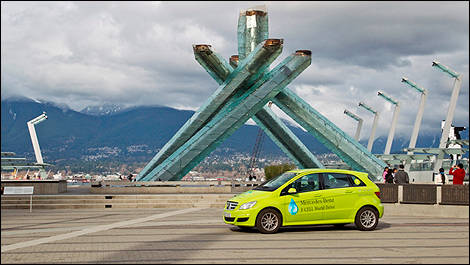Even though car manufacturers claim to be committed to putting these zero-emissions vehicles on the road, not all of them will state exactly when the cars will be available for purchase. Toyota claims to be firm in its plans to start selling its sedans in 2015, in what it sees as “favourable places” such as Japan, Scandinavia and California – locations that already have existing retail fuelling facilities. GM and Daimler, however, won’t be pinned down on firm targets.
One important piece of the puzzle is government support. As countries seek ways to reduce their dependence on foreign oil, there’s increasing interest in alternate energy sources. In 2007, Canada and the US agreed to create a “green highway,” a network of 200 hydrogen fuelling stations, between BC and California. Last year, Germany announced plans to open a network of hydrogen fuelling stations by the year 2012. There are also plans underway for a system of stations to connect Denmark, Norway, Sweden and Germany.
It looks like organizations with fleets of vehicles may lead the way in adopting hydrogen, since they can provide a central fuelling location. It’s a model already in place for forklifts in facilities such as Walmart’s new food distribution centre in Balzac, Alberta, just outside Calgary. The company estimates that in 7 years, its fleet of hydrogen-powered forklifts will result in a fuel savings cost of $2 million.
In the end, getting hydrogen cars on the road in large numbers is not really a chicken and egg scenario. It’s not about one thing coming before the other; rather, it’s about the coming together of a number of factors: consumer demand, political will, the availability of affordable hydrogen-powered vehicles and the fuel to keep them running.
One important piece of the puzzle is government support. As countries seek ways to reduce their dependence on foreign oil, there’s increasing interest in alternate energy sources. In 2007, Canada and the US agreed to create a “green highway,” a network of 200 hydrogen fuelling stations, between BC and California. Last year, Germany announced plans to open a network of hydrogen fuelling stations by the year 2012. There are also plans underway for a system of stations to connect Denmark, Norway, Sweden and Germany.
 |
| Photo: Mercedes-Benz Canada |
It looks like organizations with fleets of vehicles may lead the way in adopting hydrogen, since they can provide a central fuelling location. It’s a model already in place for forklifts in facilities such as Walmart’s new food distribution centre in Balzac, Alberta, just outside Calgary. The company estimates that in 7 years, its fleet of hydrogen-powered forklifts will result in a fuel savings cost of $2 million.
In the end, getting hydrogen cars on the road in large numbers is not really a chicken and egg scenario. It’s not about one thing coming before the other; rather, it’s about the coming together of a number of factors: consumer demand, political will, the availability of affordable hydrogen-powered vehicles and the fuel to keep them running.


